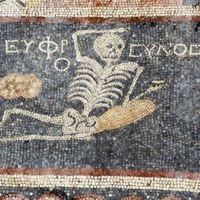Это пост для [id289126|Коли], который предложил мне тему «Африка».
Все знают об африканских корнях «солнца русской поэзии». Однако куда менее известно широкой публике, что именно в Эстонии прадед Пушкина, Абрам Петрович Ганнибал, «арап Петра Великого», познакомился со своей второй женой, в будущем прабабушкой нашего всего. Мутная, кстати, история.
Произошло это в Пярну (на тот момент город назывался Пернов, а сама территория была Лифляндией). Это сейчас Пярну — курортный городок и отличное место для какого-нибудь незатейливого романа, а тогда – это была настоящая глушь, в которую по своей воле не поедешь и не заберешься. Однако водоворот эпохи дворцовых переворотов вынес Ганнибала именно на пярнуский берег, куда его после смерти благоволителя, Петра I, сослали преподавать в военной школе математику и черчение. Это, конечно, лучше, чем быть в Тобольске под арестом, но приятного мало.
Вернемся к женщинам. Вообще-то Абрам Петрович уже был женат — в 1731 году он взял в жены гречанку. Отношения с женой, как наверное сейчас бы сказали, не сложились. Слухов, наверное, здесь больше, чем реальной правды, которую мы никогда не узнаем, однако по дошедшим до нас материалам бракоразводного процесса можно живо представить, какие южные страсти кипели на берегу этого холодного северного залива. Пушкин пишет (по семейным преданиям), что после рождения белого ребенка Ганнибал яростно обвинил свою жену в измене, за что она, якобы, попыталась его отравить вместе со своим сообщником (или любовником?). Тут дело дошло уже до суда. Ее арестовали и отправили в тюрьму. Развода, тем не менее, не последовало — не знаю, уж почему этот процесс длился так долго, но только через двадцать лет, в 1753 году, брак был официально расторгнут. На самом деле, это была довольно грустная история. Нрав у арапа, судя по всему, был вспыльчивый и несдержанный, с женой он обращался жестко, дополнить еще и совершенно не мягкими законами времени — женщину, честно говоря, очень жалко. Остаток жизни по судебному предписанию первая жена провела в монастыре. Вообще, оценивать такие истории сквозь матрицу современного взгляда на мир, очень сложно.
Кстати:
«Бывает, что от мыслей нет житья,
Разыгрывается воображенье,
Тогда, как бы двух душ отображенье,
Несчастную гречанку вижу я,
Бегущую вдоль длинного причала,
И на валу фигуру Ганнибала.
А в небесах луны латунный круг.
И никого. И бурный век вокруг.»
Это отрывок из стихотворения «Сон о Ганнибале», которое написал мой любимый Давид Самойлов в 1977 году. Как известно, поэт много лет прожил в Пярну, а эта история заинтересовала его и послужила поводом для собственной поэтической интерпретации. Всячески рекомендую — оно небольшое и читается на одном дыхании http://www.rulit.me/books/izbrannoe-read-335661-24.html
Пока шел бракоразводный процесс, Ганнибал успел жениться второй раз (при живой-то жене) — в 1736 году на девице Христине-Регине фон Шёберг, которая впоследствии родила ему 11 детей. Выжили не все, но один из них таки стал дедушкой Пушкина. Вообще же, судьба очень сильно связала Абрама Ганнибала с Эстонией: впоследствии ему была пожалована мыза Карьякюла, например, а после и ответственная должность в Ревеле. В 1742 году, с воцарением Елизаветы, его "повышают" в звании — он становится комендантом Ревельской крепости (в Старом городе сейчас висит памятная табличка). Видите, было и такое время, когда главным по военной части в Таллине был чернокожий человек. Да чего только не было в 18 веке!
#estonian_challenge
https://upload.wikimedia.org/wikipedia/commons/thumb/a/a6/Commanders_House_Hanibal_1742-52.jpg/1024px-Commanders_House_Hanibal_1742-52.jpg?1520863901429
Все знают об африканских корнях «солнца русской поэзии». Однако куда менее известно широкой публике, что именно в Эстонии прадед Пушкина, Абрам Петрович Ганнибал, «арап Петра Великого», познакомился со своей второй женой, в будущем прабабушкой нашего всего. Мутная, кстати, история.
Произошло это в Пярну (на тот момент город назывался Пернов, а сама территория была Лифляндией). Это сейчас Пярну — курортный городок и отличное место для какого-нибудь незатейливого романа, а тогда – это была настоящая глушь, в которую по своей воле не поедешь и не заберешься. Однако водоворот эпохи дворцовых переворотов вынес Ганнибала именно на пярнуский берег, куда его после смерти благоволителя, Петра I, сослали преподавать в военной школе математику и черчение. Это, конечно, лучше, чем быть в Тобольске под арестом, но приятного мало.
Вернемся к женщинам. Вообще-то Абрам Петрович уже был женат — в 1731 году он взял в жены гречанку. Отношения с женой, как наверное сейчас бы сказали, не сложились. Слухов, наверное, здесь больше, чем реальной правды, которую мы никогда не узнаем, однако по дошедшим до нас материалам бракоразводного процесса можно живо представить, какие южные страсти кипели на берегу этого холодного северного залива. Пушкин пишет (по семейным преданиям), что после рождения белого ребенка Ганнибал яростно обвинил свою жену в измене, за что она, якобы, попыталась его отравить вместе со своим сообщником (или любовником?). Тут дело дошло уже до суда. Ее арестовали и отправили в тюрьму. Развода, тем не менее, не последовало — не знаю, уж почему этот процесс длился так долго, но только через двадцать лет, в 1753 году, брак был официально расторгнут. На самом деле, это была довольно грустная история. Нрав у арапа, судя по всему, был вспыльчивый и несдержанный, с женой он обращался жестко, дополнить еще и совершенно не мягкими законами времени — женщину, честно говоря, очень жалко. Остаток жизни по судебному предписанию первая жена провела в монастыре. Вообще, оценивать такие истории сквозь матрицу современного взгляда на мир, очень сложно.
Кстати:
«Бывает, что от мыслей нет житья,
Разыгрывается воображенье,
Тогда, как бы двух душ отображенье,
Несчастную гречанку вижу я,
Бегущую вдоль длинного причала,
И на валу фигуру Ганнибала.
А в небесах луны латунный круг.
И никого. И бурный век вокруг.»
Это отрывок из стихотворения «Сон о Ганнибале», которое написал мой любимый Давид Самойлов в 1977 году. Как известно, поэт много лет прожил в Пярну, а эта история заинтересовала его и послужила поводом для собственной поэтической интерпретации. Всячески рекомендую — оно небольшое и читается на одном дыхании http://www.rulit.me/books/izbrannoe-read-335661-24.html
Пока шел бракоразводный процесс, Ганнибал успел жениться второй раз (при живой-то жене) — в 1736 году на девице Христине-Регине фон Шёберг, которая впоследствии родила ему 11 детей. Выжили не все, но один из них таки стал дедушкой Пушкина. Вообще же, судьба очень сильно связала Абрама Ганнибала с Эстонией: впоследствии ему была пожалована мыза Карьякюла, например, а после и ответственная должность в Ревеле. В 1742 году, с воцарением Елизаветы, его "повышают" в звании — он становится комендантом Ревельской крепости (в Старом городе сейчас висит памятная табличка). Видите, было и такое время, когда главным по военной части в Таллине был чернокожий человек. Да чего только не было в 18 веке!
#estonian_challenge
https://upload.wikimedia.org/wikipedia/commons/thumb/a/a6/Commanders_House_Hanibal_1742-52.jpg/1024px-Commanders_House_Hanibal_1742-52.jpg?1520863901429
This is a post for [id289126 | Kolya], who offered me the subject of “Africa”.
Everyone knows about the African roots of the "sun of Russian poetry." However, far less it is known to the general public that it was in Estonia that Pushkin’s great-grandfather, Abram Petrovich Hannibal, “the arap of Peter the Great,” met his second wife, the future great-grandmother of our whole. Muddy, by the way, the story.
It happened in Pärnu (at that time the city was called Pernov, and the territory itself was Livonia). It is now Pärnu - a resort town and a great place for some simple novel, but then - it was a real wilderness, which you can’t go to, and you won’t climb. However, the whirlpool of the epoch of palace coups brought Hannibal to the Pärnu shore, where he was exiled, Peter I, after the death, and was sent to teach mathematics and drafting in a military school. This, of course, is better than being under arrest in Tobolsk, but pleasantly enough.
Let's go back to the women. In fact, Abram Petrovich was already married - in 1731 he married a Greek woman. Relationship with my wife, as I would probably say now, did not work out. There are probably more rumors here than real truth that we will never know, but from the materials of the divorce process that have come down to us, one can vividly imagine what southern passions boiled on the shores of this cold northern bay. Pushkin writes (according to family traditions) that after the birth of a white child, Hannibal violently accused his wife of treason, for which she allegedly tried to poison him with his accomplice (or her lover?). Here it came to court. She was arrested and sent to prison. Divorce, however, did not follow — I don’t know why this process lasted so long, but only twenty years later, in 1753, the marriage was officially terminated. Actually, it was a rather sad story. The character of the arap, apparently, was quick-tempered and unrestrained, he treated his wife harshly, and to supplement with the completely non-mild laws of the time - a woman, to be honest, very sorry. The rest of the life of the court ordered the first wife to spend in the monastery. In general, it is very difficult to evaluate such stories through the matrix of the modern world view.
By the way:
"It happens that there is no life from thoughts,
Imagination played out
Then, like two showers,
I see an unhappy Greek woman
Running along the long pier,
And on the shaft is the figure of Hannibal.
And in the sky of the moon there is a brass circle.
And no one. And a stormy age around. ”
This is an excerpt from the poem "The Dream of Hannibal," which was written by my beloved David Samoilov in 1977. As you know, the poet lived for many years in Pärnu, and this story interested him and served as a pretext for his own poetic interpretation. I strongly recommend it - it is small and is read in one breath http://www.rulit.me/books/izbrannoe-read-335661-24.html
While the divorce proceedings were under way, Hannibal managed to marry a second time (while his wife was alive) - in 1736 the girl Christine Regina von Schöberg, who later bore him 11 children. Not all survived, but one of them did become Pushkin's grandfather. In general, fate very strongly linked Abram Hannibal with Estonia: subsequently, Karjaküla Manor was granted to him, for example, and after that a responsible position in Reval. In 1742, with the accession of Elizabeth, he was "promoted" in rank - he became the commandant of the Revel fortress (a memorial plaque now hangs in the Old Town). You see, there was a time when the main man in the military unit in Tallinn was a black man. Yes, what just was not in the 18th century!
#estonian_challenge
https://upload.wikimedia.org/wikipedia/commons/thumb/a/a6/Commanders_House_Hanibal_1742-52.jpg/1024px-Commanders_House_Hanibal_1742-52.jpg?1520863901429
Everyone knows about the African roots of the "sun of Russian poetry." However, far less it is known to the general public that it was in Estonia that Pushkin’s great-grandfather, Abram Petrovich Hannibal, “the arap of Peter the Great,” met his second wife, the future great-grandmother of our whole. Muddy, by the way, the story.
It happened in Pärnu (at that time the city was called Pernov, and the territory itself was Livonia). It is now Pärnu - a resort town and a great place for some simple novel, but then - it was a real wilderness, which you can’t go to, and you won’t climb. However, the whirlpool of the epoch of palace coups brought Hannibal to the Pärnu shore, where he was exiled, Peter I, after the death, and was sent to teach mathematics and drafting in a military school. This, of course, is better than being under arrest in Tobolsk, but pleasantly enough.
Let's go back to the women. In fact, Abram Petrovich was already married - in 1731 he married a Greek woman. Relationship with my wife, as I would probably say now, did not work out. There are probably more rumors here than real truth that we will never know, but from the materials of the divorce process that have come down to us, one can vividly imagine what southern passions boiled on the shores of this cold northern bay. Pushkin writes (according to family traditions) that after the birth of a white child, Hannibal violently accused his wife of treason, for which she allegedly tried to poison him with his accomplice (or her lover?). Here it came to court. She was arrested and sent to prison. Divorce, however, did not follow — I don’t know why this process lasted so long, but only twenty years later, in 1753, the marriage was officially terminated. Actually, it was a rather sad story. The character of the arap, apparently, was quick-tempered and unrestrained, he treated his wife harshly, and to supplement with the completely non-mild laws of the time - a woman, to be honest, very sorry. The rest of the life of the court ordered the first wife to spend in the monastery. In general, it is very difficult to evaluate such stories through the matrix of the modern world view.
By the way:
"It happens that there is no life from thoughts,
Imagination played out
Then, like two showers,
I see an unhappy Greek woman
Running along the long pier,
And on the shaft is the figure of Hannibal.
And in the sky of the moon there is a brass circle.
And no one. And a stormy age around. ”
This is an excerpt from the poem "The Dream of Hannibal," which was written by my beloved David Samoilov in 1977. As you know, the poet lived for many years in Pärnu, and this story interested him and served as a pretext for his own poetic interpretation. I strongly recommend it - it is small and is read in one breath http://www.rulit.me/books/izbrannoe-read-335661-24.html
While the divorce proceedings were under way, Hannibal managed to marry a second time (while his wife was alive) - in 1736 the girl Christine Regina von Schöberg, who later bore him 11 children. Not all survived, but one of them did become Pushkin's grandfather. In general, fate very strongly linked Abram Hannibal with Estonia: subsequently, Karjaküla Manor was granted to him, for example, and after that a responsible position in Reval. In 1742, with the accession of Elizabeth, he was "promoted" in rank - he became the commandant of the Revel fortress (a memorial plaque now hangs in the Old Town). You see, there was a time when the main man in the military unit in Tallinn was a black man. Yes, what just was not in the 18th century!
#estonian_challenge
https://upload.wikimedia.org/wikipedia/commons/thumb/a/a6/Commanders_House_Hanibal_1742-52.jpg/1024px-Commanders_House_Hanibal_1742-52.jpg?1520863901429

У записи 37 лайков,
2 репостов,
1242 просмотров.
2 репостов,
1242 просмотров.
Эту запись оставил(а) на своей стене Полина Оскольская

























































